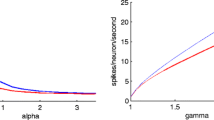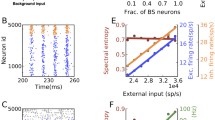Abstract
Refractoriness is one of the most fundamental states of neural firing activity, in which neurons that have just fired are unable to produce another spike, regardless of the strength of afferent stimuli. Another essential and unavoidable feature of neural systems is the existence of noise. To study the role of these essential factors in spatiotemporal pattern formation in neural systems, a spatially expended neural network model is constructed, with the dynamics of its individual neurons capturing the three most essential states of the neural firing behavior: firing, refractory and resting, and the network topology consistent with the widely observed center-surround coupling manner in the real brain. By changing the refractory period with and without noise in a systematic way in the network, it is shown numerically and analytically that without refractoriness, or when the refractory period is smaller than a certain value, the collective activity pattern of the system consists of localized, oscillating patterns. However, when the refractory period is greater than a certain value, crescent-shaped, localized propagating patterns emerge in the presence of noise. It is further illustrated that the formation of the dynamical spiking patterns is due to a symmetry breaking mechanism, refractoriness-induced symmetry breaking; that is generated by the interplay of noise and refractoriness in the network model. This refractoriness-induced symmetry breaking provides a novel perspective on the emergence of localized, spiking wave patterns or spike timing sequences as ubiquitously observed in real neural systems; it therefore suggests that refractoriness may benefit neural systems in their temporal information processing, rather than limiting the performance of neurons, as has been conventionally thought. Our results also highlight the importance of considering noise in studying spatially extended neural systems, where it may facilitate the formation of spatiotemporal order.
Similar content being viewed by others
References
Abeles M (1991) Corticonics: neural circuits of the cerebral cortex. Cambridge University Press, Cambridge
Amari S (1977) Dynamics of pattern formation in lateral-inhibition type neural fields. Biol Cybern 27: 77–87
Arieli A, Shoham D, Hildesheim R, Grinvald A (1995) Coherent spatiotemporal patterns of ongoing activity revealed by real-time optical imaging coupled with single-unit recording in the cat visual cortex. J Neurophysiol 73: 2072–2093
Benayoun M, Cowan JD, van Drongelen W, Wallace E (2010) Avalanches in a stochastic model of spiking neurons. PLoS Comput Biol 6: e1000846
Berry MJ, Meister M (1998) Refractoriness and neural precision. J Neurosci 18: 2200–2211
Bressloff PC (2012) Spatiotemporal dynamics of continuum neural fields. J Phys A 45: 033001
Bressloff PC, Kilpatrick ZP (2011) Two-dimensional bumps in piecewise smooth neural fields with synaptic depression. SIAM J Appl Math 71: 379–408
Buice MA, Cowan JD (2007) Field theoretic approach to fluctuation effects in neural networks. Phys Rev E 75: 051919
Chow CC, Coombes S (2006) Existence and wandering of bumps in a spiking neural network model. SIAM J Appl Dyn syst 5: 552–574
Chu PH, Milton JG, Cowan JD (1994) Connectivity and the dynamics of integrate-and-fire neural networks. Int J Bifurcation Chaos 4: 237–243
Coombes S (2005) Waves, bumps, and patterns in neural field theories. Biol Cybern 93: 91–108
Coombes S, Owen MR (2005) Bumps, breathers, and waves in a neural network with spike frequency adaptation. Phys Rev Lett 94: 148102
Cowan JD (1991) Stochastic neurodynamics. In: Touretzky DS, Lippman RP, Moody JE (eds) Advances in neural information processing systems, vol 3. Morgan Kaufmann Publishers, San Mateo, CA, p 62
Drossel B, Schwabl F (1992) Self-organized critical forest-fire model. Phys Rev Lett 69: 1629–1632
Doiron B, Rinzel J, Reyes A (2006) Stochastic synchronization in finite size spiking networks. Phys Rev E 74: 30903
Ermentrout B (1998) Neural networks as spatiotemporal pattern-forming systems. Rep Prog Phys 61: 353–430
Ermentrout GB, Kleinfeld D (2001) Traveling electrical waves in cortex: insight from phase dynamics and speculation on a computational role. Neuron 29: 33–44
Faisal AA, Selen LPJ, Wolpert DM (2008) Noise in nervous system. Nat Rev Neurosci 9: 292–303
Ferezou I, Haiss F, Gentet LJ, Aronoff R, Weber B, Petersen CC (2007) Spatiotemporal dynamics of cortical sensorimotor integration in behaving mice. Neuron 56: 907–923
Feller MB, Butts DA, Aaron HL, Rokhsar DS, Shatz CJ (1997) Dynamic processes shape spatiotemporal properties of retinal waves. Neuron 19: 293–306
Fohlmeister C, Gerstner W, Ritz R, van Hemmen JL (1995) Spontaneous excitation in the visual cortex: stripes, spirals, rings and collective bursts. Neural Comput 7: 905–914
Folias SE, Bressloff PC (2004) Breathing pulses in an excitatory neural network. SIAM J Appl Dyn Syst 3: 378–407
Freeman WJ, Barrie JM (2000) Analysis of spatial patterns of phase in neocortical gamma EEGs in rabbit. J Neurophysiol 84: 1266–1278
Greenberg JM, Hastings SP (1978) Spatial patterns for discrete models of diffusion in excitable media. SIAM J Appl Math 43: 515–523
Gong P, van Leeuwen C (2009) Distributed dynamical computation in neural circuits with propagating coherent activity patterns. PLoS Comput Biol 5: e1000611
Gong P, Robinson PA (2012) Dynamic pattern formation and collisions in networks of excitable elements. Phys Rev E 85: 055101(R)
Han F, Caporale N, Dan Y (2008) Reverberation of recent visual experience in spontaneous cortical waves. Neuron 60: 321–327
Hampel D, Lansky P (2008) On the estimation of refractory period. J Neurosci Methods 171: 288–295
Hodgkin AL, Huxley AF (1952) A quantitative description of membrane current and its application to conduction and excitable in nerve. J Physiol 117: 500–544
Hopfield J (1984) Neurons with graded response have collective computational properties like those of two-state neurons. Proc Natl Acad Sci USA 81: 3088–3092
Huang X et al (2004) Spiral waves in disinhibited mammalian neocortex. J Neurosci 24: 9897–9902
Hutt A, Longtin A, Schimansky-Geier L (2008) Additive noise-induces Turing transitions in spatial systems with application to neural fields and the swift Hohenberg equation. Physica D 237: 755–773
Jung P, Jung P (1995) Noise controlled spiral growth in excitable media. Chaos 5: 458–462
Kandel E, Schwartz J, Jessell T (2000) Principles of neural science, 4th edn. McGraw-Hill Medical, New York
Kleinfeld D, Delaney KR (1996) Distributed representation of vibrissa movement in the upper layers of somatosensory cortex revealed with voltage-sensitive dyes. J Comp Neurol 375: 89–108
Koch C (1999) Biophysics of Computation: Information Processing in Single Neurons. Oxford University Press
Lindner B, Garcia-Ojalvo J, Neiman A, Schimansky-Geier L (2004) Effects of noise in excitable systems. Phys Rep 392: 321–424
Lu Y, Sato Y, Amari S (2011) Traveling bumps and their collisions in a two-dimensional neural field. Neural Comput 23: 1248–1260
Martin KAC (1988) From single cells to simple circuits in the cerebral cortex. Q J Exp Physiol 73: 637–702
Pinto DJ, Ermentrout GB (2001) Spatially structured activity in a synaptically coupled neuronal networks: traveling fronts and pulses. SIAM J Appl Math 62: 206–225
Roxin A, Hakim V, Brunel N (2008) The statistics of repeating patterns of cortical activity can be reproduced by a model network of stochastic binary neurons. J Neurosci 28: 10734–10745
Rubino D, Robbins KA, Hatsopoulos NG (2006) Propagating waves mediate information transfer in the motor cortex. Nat Neurosci 9: 1549–1557
Sagues F, Sancho JM, Garcia-Ojalvo J (2007) Spatiotemporal order out of noise. Rev Mod Phys 79: 829–882
Schuett S, Bonhoeffer T, Hubener M (2002) Mapping retinotopic structure in mouse visual cortex with optical imaging. J Neurosci 22: 6549–6559
Sejnowski TJ (1995) Pattern recognition time for a new neural code. Nature 376: 21–22
Singer W (1999) Time as coding space. Curr Opin Neurobiol 9: 189–194
Softky WR, Koch C (1993) The highly irregular firing of cortical cells is inconsistent with temporal integration of random EPSPs. J Neurosci 13: 334–350
Taylor JG (1999) Neural ‘bubble’ dynamics in two dimensions: foundations. Biol Cybern 80: 393–409
Teich MC, Matin L, Cantor BI (1978) Refractoriness in maintained discharge of the cat’s retinal ganglion cell. J Opt Soc Am 68: 386–402
Wallace E, Benayoun M, van Drongelen W, Cowan JD (2011) Emergent oscillations in networks of stochastic spiking neurons. PLoS ONE 6: e14804
Werner H, Richter T (2001) Circular stationary solutions in two-dimensional neural fields. Biol Cybern 85: 211–217
Wiensenfeld K, Moss F (1995) Stochastic resonance and the benefits of noise: from ice ages to crayfish and squids. Nature 173: 33–36
Wu JY, Huang X, Zhang C (2008) Propagating waves of activity in the neocortex: what they are, what they do. Neuroscientist 14: 487–502
Author information
Authors and Affiliations
Corresponding author
Rights and permissions
About this article
Cite this article
Gong, P., Loi, S.T.C., Robinson, P.A. et al. Spatiotemporal pattern formation in two-dimensional neural circuits: roles of refractoriness and noise. Biol Cybern 107, 1–13 (2013). https://doi.org/10.1007/s00422-012-0518-2
Received:
Accepted:
Published:
Issue Date:
DOI: https://doi.org/10.1007/s00422-012-0518-2




